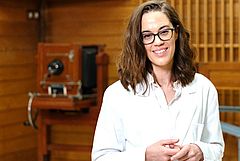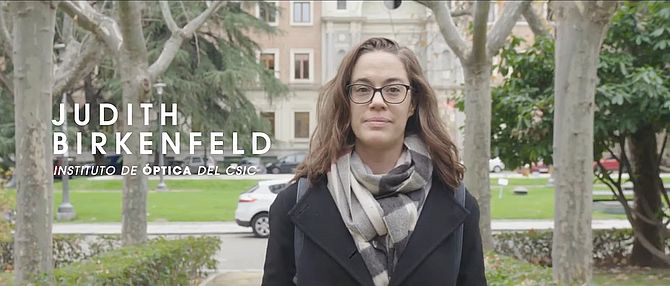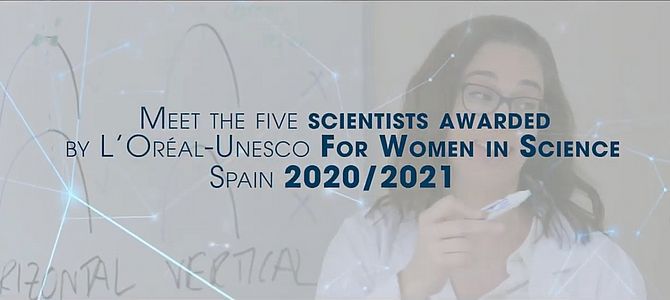Judith S. Birkenfeld from Germany dreamed of becoming a veterinarian as a child, but it made an impact on her when at the age of 10 her father, a high school physics teacher, built a solar car with his students and a Foucault pendulum at home. "I also spent a year in Miami in high school, and the woman I lived with during that time was the first scientist I met. She was working on environmental issues and she was the one who taught me what it meant to be a scientist," she recalls.
She studied physics (Diplom) and medical physics (MSc) at the University of Heidelberg in Germany which shaped her career. "When I was studying physics there, I had several classes with Professor Josef Bille, considered the father of the eye laser and adaptive optics in ophthalmology, a true innovator, and winner of the prestigious 'European Inventor Lifetime Achievement Award' for his patents on surgical lasers for laser eye surgery (LASIK). He was an amazing teacher, and got the whole class hooked on Biomedical Optics with his endless enthusiasm. It was because of him that I fell in love with eye research."
During her studies, Judith obtained a DAAD scholarship at Harvard Medical School (HMS) in Boston, USA, and a Leonardo scholarship at the Universidad Autónoma de Madrid. After graduation she moved to Madrid to start her PhD in physics at the IO-CSIC (Institute of Optics) in collaboration with the Complutense University. At the end of her PhD she was selected as "M+Vision Catalyst Fellow" at the Massachusetts Institute of Technology (MIT) in Boston. Subsequently, she started a project at the Wellman Center for Photomedicine/HMS in collaboration with the IO-CSIC with a Marie Skłodowska-Curie Action grant. "This was the project that brought me back to Spain. As part of the Visual Optics and Biophotonics group, I am currently working within a European project (Imcustomeye)," says Judith.
Her research aims to develop a system for the early detection of an eye disease called keratoconus, which affects the cornea and can cause a serious loss of visual quality. Keratoconus is a degenerative disease that affects 1 in 2,000 people and usually appears between the ages of 16 and 25, so early detection is key. "Our research will make it possible to improve the quality of life of many people. Early detection will result in early intervention so that the progression of the disease can be slowed down. That would decrease the need for corneal transplants, and would lower healthcare costs, so it would also have an impact on our healthcare system," explains the scientist.
"To achieve these goals, we will work with non-contact technologies that allow us to observe internal ocular structures and we will develop new methods to investigate the microstructure of collagen in the cornea. In addition, we will develop novel AI methods to differentiate between normal and abnormal corneas," she explains.
"The world around us is beautiful, but unfortunately we can't all admire it," says Judith, who says her dream is to be able to develop an easy-to-use tool that will check your eyes in the morning and tell you when it's time to pay a visit to the ophthalmologist.
Women in science
Judith points out that it is easier to be a female scientist today "because we are standing on the shoulders of women scientists who have mostly worked without ever getting any credit or recognition, and who have spent a lot of their energy in getting our basic rights".
Judith explains that "being in a minority at work, in this case being a woman in a work environment of men, is like the state in which you find yourself when you have moved to another country, or even to another city. Let's say everything is in order, you have a new apartment, you find a school for the kids, and the people are really nice. But there is a language barrier and some unwritten social rules that are different from what you are used to, and you find it difficult to apply. So, from the beginning, it's hard to relax and you lose some of your daily energy in trying to understand and be understood. And you also notice that you are in a kind of state where you are very visible because you are different, but, on the other hand, you are invisible when it comes to job promotions. And for most women it takes a while to understand that this doesn't happen because we do a worse job than our male counterparts, it happens because of a bias that exists in our society."
For this reason, Judith advocates normalizing the image of women as scientists: "it should not be anomalous or rare to see women scientists working in high-level positions. The visibility of Rosa Menéndez López, the president of the CSIC, is an excellent example. She took the position with such ease that she left no doubt that she would be able to do it. But we need many more examples to implement this normality in our society, and I am absolutely sure that there are brilliant women scientists who can take up high-level jobs at any time."






